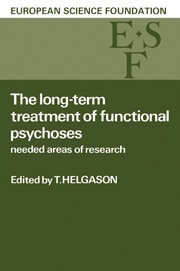Book contents
- Frontmatter
- Contents
- List of Participants
- Introduction
- I Organisational Aspects of Long-term Treatment
- II Patients Aspects of Long-term Treatment
- III Public Health Aspectsof Long-term Treatment
- Introduction to public health aspects of chronic illness and long-term treatment
- Evaluation of long-term community care for patients with schizophrenia
- Case registers for monitoring treatment outcome in chronic functional psychoses
- Socialdisabilityand chronicmentaldisorder
- The neglect of the patient with chronic functional psychosis: the need for further research
- Suicidesand functional psychoses
- Interaction with families
- Cost-effectiveness analysis
- Consumption of services-European aspects
- Index
Evaluation of long-term community care for patients with schizophrenia
from III - Public Health Aspectsof Long-term Treatment
- Frontmatter
- Contents
- List of Participants
- Introduction
- I Organisational Aspects of Long-term Treatment
- II Patients Aspects of Long-term Treatment
- III Public Health Aspectsof Long-term Treatment
- Introduction to public health aspects of chronic illness and long-term treatment
- Evaluation of long-term community care for patients with schizophrenia
- Case registers for monitoring treatment outcome in chronic functional psychoses
- Socialdisabilityand chronicmentaldisorder
- The neglect of the patient with chronic functional psychosis: the need for further research
- Suicidesand functional psychoses
- Interaction with families
- Cost-effectiveness analysis
- Consumption of services-European aspects
- Index
Summary
In the past a patient with a chronically disabling psychiatric illness such as schizophrenia has been treated by hospitalization lasting years or, often, a lifetime. Nowadays the trend has been to shorten hospital stay markedly and to continue treatment in the community through aftercare or the use of complementary services.
A main factor that has influenced the movement to treat the chronically disabled in the community rather than in the hospital has been clinical evidence of the debilitating effects of long-term institutional care. The treatment of chronic illnessshould focus upon helping patients to normalize their lives to- the greatest possible degree and to raise their level of functioning; this is a role which the remote psychiatric hospital in particular can hardly fulfill. Whereas the development of drug therapy has encouraged the shift from hospital to community care, there is only a crude understanding of the forces in the community that help contain psychotic behaviour and help maintain the psychotic at a reasonable level of functioning.
Attkisson et al. (1978) pointed out, viewed from the perspective of the individual client a good care-giving system is one that does more than simply reduce a single problem or increase some restricted level of positive functioning. A good service must also be readily available when needed and operate in a fashion that does not create undue burdens for the consumer.
In practice, it is frequently observed that many persons seeking services have multiple problems and may therefore require simultaneous or well-integrated sequential treatments. Criteria for evaluating the effectiveness and adequacy of psychiatric care must therefore include a measure of programme continuity; this means coordination between services or, at least, of the degree to which a client can be referred from one institution to another.
Since 1969, a comprehensive community mental health service has gradually been set up in Mannheim, an industrial city with about 310000 inhabitants. Complementary services have been opened step by step according to need. On 1 January 1982, the complementary services comprised 3 homes providing 110 places and 4 sheltered apartments with 27 places; that is a total of 137 sheltered places for mentally ill persons (not counting homes for the elderly or psychogeriatric patients).
- Type
- Chapter
- Information
- The Long-Term Treatment of Functional PsychosesNeeded Areas of Research, pp. 183 - 196Publisher: Cambridge University PressPrint publication year: 1985

